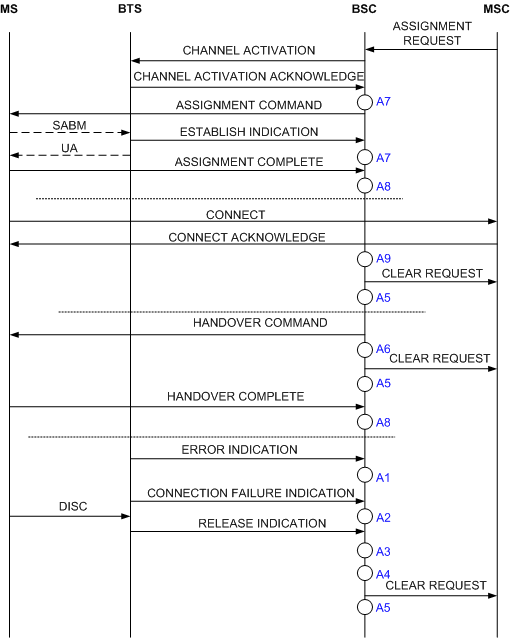Measurement Counter
CM330:CELL_TRAF_CH_CALL_DROPS_IN_STABLE_STATE
Description
This measurement provides the number of calls released because of the ERR IND, CONN FAIL IND, and REL IND messages received by the BSC after the MS seizes a traffic channel.
Unit
Integer number or integer.
Measurement Point
When a TCH is seized to carry traffic during a call, this counter is measured in the following situations:
1. The BSC receives an ERROR INDICATION message from the BTS because of the abnormal connection on the radio link layer. For details, refer to GSM Rec. 08.58.
2. The BSC receives a CONNECTION FAILURE INDICATION message from the BTS because of link fault or hardware fault on the radio link layer. For details, refer to GSM Rec. 08.58.
3. When receiving a DISC frame on a link layer connection in multi-frame mode, the BTS sends a REL IND message to BSC. For details, refer to GSM Rec. 08.58.
This counter is calculated at A1, A2, and A3, as shown in Figure 1.

A1: Call Drops Due to ERR IND Received in Stable State, Call Drops Due to the ERR IND Received on the TRX in the Underlaid Subcell in Stable State, Call Drops Due to the ERR IND Received on the TRX in the Overlaid Subcell in Stable State |
A2: Call Drops Due to the CONN FAIL IND Received in Stable State, Call Drops Due to the CONN FAIL IND Received on the TRX in the Underlaid Subcell in Stable State, Call Drops Due to the CONN FAIL IND Received on the TRX in the Overlaid Subcell in Stable State |
A3: Call Drops Due to REL IND Received in Stable State, Call Drops Due to the REL IND Received on the TRX in the Underlaid Subcell in Stable State, Call Drops Due to the REL IND Received on the TRX in the Overlaid Subcell in Stable State |
A4: Call Drops Due to No MRs from MS for a Long Time, Call Drops Due to No MR from the MS on the TRX in the Underlaid Subcell, Call Drops Due to No MR from the MS on the TRX in the Overlaid Subcell, Call Drops due to Abis Terrestrial Link Failure, Call Drops Due to Abis Terrestrial Link Failure on the TRX in the Underlaid Subcell, Call Drops Due to Abis Terrestrial Link Failure on the TRX in the Overlaid Subcell, Call Drops Due to Abis Link Failures in Stable Loopback State, Call Drops Due to Equipment Failure, Call Drops Due to TRX Failure in the Underlaid Subcell, Call Drops Due to TRX Failure in the Overlaid Subcell, Call Drops Due to Resource Check, Call Drops Due to Resource Check on the TRX in the Underlaid Subcell, Call Drops Due to Resource Check on the TRX in the Overlaid Subcell, Call Drops Due to Handover Failure During the Loopback, Call Drops Due to Other Causes in Stable State |
A5: Clear Requests Sent on the A Interface, Call Drops after Answer, Call Drops After Answer on the TRX in the Underlaid Subcell, Call Drops After Answer on the TRX in the Overlaid Subcell |
A6: Call Drops Due to Forced Handover, Call Drops Due to Forced Handover on the TRX in the Underlaid Subcell, Call Drops Due to Forced Handover on the TRX in the Overlaid Subcell, Failed Internal Intra-Cell Handovers (Timer Expired) |
A7: Call Drops Due to Loopback Start Failure |
A8: Successful TCH Seizures on the TRX in the Underlaid Subcell, Successful TCH Seizures on the TRX in the Overlaid Subcell, Call Drops Due to Failures to Return to Normal Call from Loopback |
A9: Successful Connections |
Formula
Call Drops on Radio Interface in Stable State (Traffic Channel) =
[Call Drops on TCH in Stable State (Error Indication)] +
[Call Drops on TCH in Stable State (Connection Failure)] +
[Call Drops on Traffic Channel in Stable State (Release Indication)]